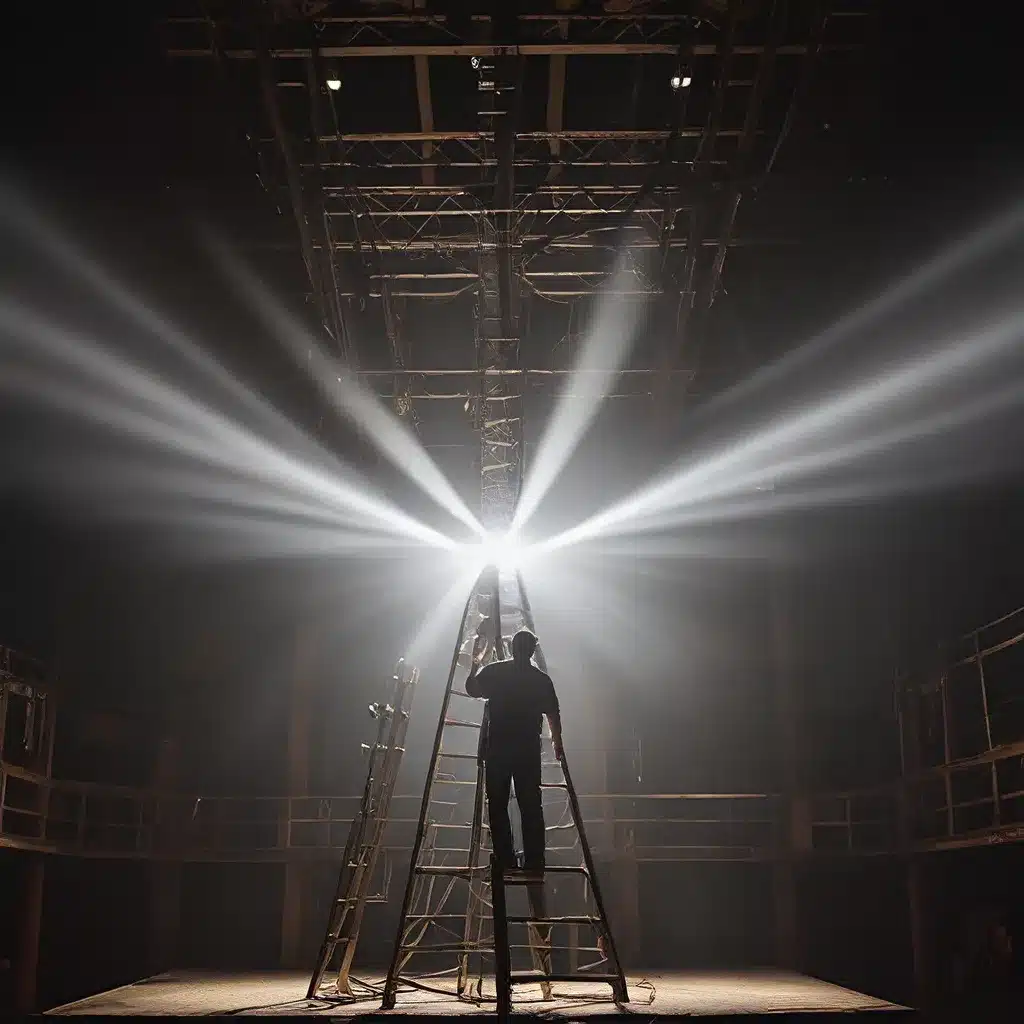
The Unsung Heroes Behind the Spotlight
As I step onto the stage of the Musical Theater Center, the bright lights immediately capture my attention. The vibrant colors, the crisp shadows, and the way the light seems to dance across the set – it’s all so captivating. But what most people don’t realize is the incredible amount of work that goes into creating this magical visual experience.
Behind the scenes, a dedicated team of theater electricians toil away, meticulously arranging the lighting equipment, programming the cues, and ensuring that every beam of light is precisely where it needs to be. These unsung heroes are the true artists responsible for bringing the stage to life, and their work is nothing short of illuminating.
The Art of Stage Lighting
To truly appreciate the role of the theater electrician, we first need to understand the fundamental principles of stage lighting. As Illuminated Integration eloquently explains, stage lighting is an art form in its own right. It’s used to “illuminate a performance venue and make an impact on an event, giving visual direction and shaping the environment.”
The goal of stage lighting is not limited to simply providing adequate illumination. It’s about creating a specific mood, guiding the audience’s attention, and enhancing the overall theatrical experience. As I’ve learned, the right lighting can “capture the audience’s attention and enhance a stage production in a number of ways.”
The Lighting Designer’s Toolkit
Theater electricians work closely with lighting designers to bring their creative visions to life. And the designers have a vast array of tools at their disposal, each with its own unique purpose and capabilities.
Illuminated Integration outlines some of the most common stage lighting fixtures:
| Fixture | Description |
|---|---|
| Ellipsoidal Reflector Spotlight | Produces an intense, well-defined beam of light perfect for front lighting. Can be adjusted for soft or sharp edges, and can hold gobos and gels for patterns and colors. |
| Followspot | Casts an intense, focused beam of light to highlight a moving performer. Allows for real-time adjustments to size, intensity, and color. |
| Fresnel Spotlight | Unique lens design creates a soft, even wash of light, though it can also produce more narrow beams. Cannot use shutters or patterns. |
| PAR Can | Sealed-beam lamps in a cylindrical casing, similar to vehicle headlights. Straightforward design with limited adjustability, but can use gels for color. |
| Floodlight | Large, movable fixture that distributes light evenly above and below the horizontal axis, or more in one direction. |
| Cyc Light | Open-faced fixture that provides an even wash of light over a cyclorama or other vertical surface. |
| Strip Light | Horizontal row of multiple lamps, used to add broad color coverage to a stage. |
These tools, combined with the creative use of color and texture, allow lighting designers to transform the visual landscape of a production, evoking specific moods and guiding the audience’s focus.
Bringing the Vision to Life
As an experienced lighting designer and professor once explained, there is no one-size-fits-all approach to lighting design. Each new production requires a unique plan, starting with a careful analysis of the script, the set, and the director’s vision.
The first step is to divide the stage into distinct lighting areas, each with its own color and intensity controls. This allows the designer to create subtle shifts in mood and focus as the action moves across the stage.
Next, the designer must consider the overall color scheme. Will certain areas need their own distinct hues, or can adjacent segments be grouped together? Will the lighting shift from warm to cool tones to reflect changes in the story? These are the types of decisions that require careful thought and planning.
Finally, the designer must work closely with the theater electricians to ensure the lighting equipment is properly installed and configured. As Illuminated Integration emphasizes, this is a task best left to professionals who have the necessary expertise and equipment. The electricians will carefully attach the fixtures to pipes or trusses, using safety cables to secure them in place. They’ll also ensure all the cabling is neatly routed, so it doesn’t become a tripping hazard.
The Electrician’s Art
But the work of the theater electrician doesn’t end there. During the performance, they must be constantly vigilant, monitoring the lighting system and responding quickly to any issues that arise. They’ll adjust the intensity of individual fixtures, tweak the color temperatures, and even make real-time changes to the lighting cues as the action unfolds on stage.
It’s a delicate dance, requiring split-second timing and an almost intuitive understanding of the performance. The electricians must anticipate the needs of the performers, the director, and the audience, all while maintaining the illusion of effortless perfection.
And let’s not forget the hours of preparation that go into each production. Before the first rehearsal, the electricians will spend countless hours programming the lighting sequences, testing the equipment, and fine-tuning the design. It’s a meticulous and often tedious process, but one that is absolutely essential to the success of the show.
The Unsung Heroes
As I watch the performance unfold, the true artistry of the theater electricians becomes increasingly apparent. The way the light ebbs and flows, the subtle shifts in color and intensity, the dramatic shadows that create a sense of depth and dimension – it’s all the result of their tireless efforts.
Yet, these individuals rarely receive the recognition they deserve. They toil away in the shadows, content to let the performers and the designers take the spotlight. But without their dedication and expertise, the show simply wouldn’t be possible.
So, the next time you’re mesmerized by the magic of a live performance, take a moment to appreciate the unsung heroes behind the curtain – the theater electricians who are lighting the way to a truly unforgettable experience.

